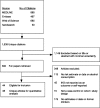Ischemic heart disease mortality and morbidity rates in former drinkers: a meta-analysis - PubMed (original) (raw)
Meta-Analysis
. 2011 Feb 1;173(3):245-58.
doi: 10.1093/aje/kwq364. Epub 2010 Dec 14.
Affiliations
- PMID: 21156750
- PMCID: PMC3105267
- DOI: 10.1093/aje/kwq364
Meta-Analysis
Ischemic heart disease mortality and morbidity rates in former drinkers: a meta-analysis
Michael Roerecke et al. Am J Epidemiol. 2011.
Abstract
Current abstainers from alcohol have been identified as an inadequate reference group in epidemiologic studies of the effects of alcohol, because inclusion of former drinkers might lead to overestimation of the protective effects and underestimation of the detrimental effects of drinking alcohol. The authors' objective in the current study was to quantify this association for ischemic heart disease (IHD). Electronic databases were systematically searched for relevant case-control or cohort studies published from 1980 to 2010. Thirty-eight articles fulfilled the inclusion criteria, contributing a total of 5,613 IHD events and 12,097 controls among case-control studies and 1,387 events with combined endpoints and 7,183 events stratified by endpoint among 232,621 persons at risk among cohort studies. Pooled estimates for the subset stratified by sex and endpoint showed a significantly increased risk among former drinkers compared with long-term abstainers for IHD mortality ( among men; relative risk = 1.25, 95% confidence interval: 1.15, 1.36; among women relative risk = 1.54, 95% confidence interval: 1.17, 2.03). For IHD morbidity, the estimates for both sexes were close to unity and not statistically significant. Results were robust in several sensitivity analyses. In future studies, researchers should separate former drinkers from the reference category to obtain unbiased effect estimates. Implications for the overall beneficial and detrimental effects of alcohol consumption on IHD are discussed below.
Figures
Figure 1.
Selection process used in a study of the effect of former drinking on ischemic heart disease risk, 1980–2010.
Figure 2.
Pooled relative risk of ischemic heart disease mortality among former drinkers compared with abstainers in men, stratified by sex and endpoint, 1980–2010. CI, confidence interval.
Figure 3.
Pooled relative risk of ischemic heart disease mortality among former drinkers compared with abstainers in women, stratified by sex and endpoint. Weights are from random-effects models, 1980–2010. CI, confidence interval.
Figure 4.
Pooled relative risk of ischemic heart disease morbidity among former drinkers compared with abstainers in men, stratified by sex and endpoint, 1980–2010. CI, confidence interval.
Figure 5.
Pooled relative risk of ischemic heart disease morbidity among former drinkers compared with abstainers in women, stratified by sex and endpoint. Weights are from random-effects models, 1980–2010. CI, confidence interval.
Similar articles
- The cardioprotective association of average alcohol consumption and ischaemic heart disease: a systematic review and meta-analysis.
Roerecke M, Rehm J. Roerecke M, et al. Addiction. 2012 Jul;107(7):1246-60. doi: 10.1111/j.1360-0443.2012.03780.x. Epub 2012 Mar 21. Addiction. 2012. PMID: 22229788 Free PMC article. Review. - Heavy drinking occasions in relation to ischaemic heart disease mortality-- an 11-22 year follow-up of the 1984 and 1995 US National Alcohol Surveys.
Roerecke M, Greenfield TK, Kerr WC, Bondy S, Cohen J, Rehm J. Roerecke M, et al. Int J Epidemiol. 2011 Oct;40(5):1401-10. doi: 10.1093/ije/dyr129. Epub 2011 Sep 23. Int J Epidemiol. 2011. PMID: 22039198 Free PMC article. - Irregular heavy drinking occasions and risk of ischemic heart disease: a systematic review and meta-analysis.
Roerecke M, Rehm J. Roerecke M, et al. Am J Epidemiol. 2010 Mar 15;171(6):633-44. doi: 10.1093/aje/kwp451. Epub 2010 Feb 8. Am J Epidemiol. 2010. PMID: 20142394 Review. - Binge drinking, drinking frequency, and risk of ischaemic heart disease: a population-based cohort study.
Skov-Ettrup LS, Eliasen M, Ekholm O, Grønbæk M, Tolstrup JS. Skov-Ettrup LS, et al. Scand J Public Health. 2011 Dec;39(8):880-7. doi: 10.1177/1403494811425605. Epub 2011 Oct 19. Scand J Public Health. 2011. PMID: 22013157
Cited by
- The cardioprotective association of average alcohol consumption and ischaemic heart disease: a systematic review and meta-analysis.
Roerecke M, Rehm J. Roerecke M, et al. Addiction. 2012 Jul;107(7):1246-60. doi: 10.1111/j.1360-0443.2012.03780.x. Epub 2012 Mar 21. Addiction. 2012. PMID: 22229788 Free PMC article. Review. - Prospective correlates of drinking cessation: variation across the life-course.
Dawson DA, Goldstein RB, Grant BF. Dawson DA, et al. Addiction. 2013 Apr;108(4):712-22. doi: 10.1111/add.12079. Epub 2013 Feb 11. Addiction. 2013. PMID: 23216848 Free PMC article. - Ischemic heart disease and its related factors in Mongolia: a nationwide survey.
Enkh-Oyun T, Kotani K, Davaalkham D, Aoyama Y, Tsuboi S, Oguma T, Nakamura Y. Enkh-Oyun T, et al. J Community Health. 2013 Oct;38(5):919-25. doi: 10.1007/s10900-013-9702-0. J Community Health. 2013. PMID: 23677570 - Physical activity and substance use among Canadian adolescents: Examining the moderating role of school connectedness.
Fagan MJ, Duncan MJ, Bedi RP, Puterman E, Leatherdale ST, Faulkner G. Fagan MJ, et al. Front Public Health. 2022 Nov 10;10:889987. doi: 10.3389/fpubh.2022.889987. eCollection 2022. Front Public Health. 2022. PMID: 36438291 Free PMC article. - Alcohol Consumption and Mortality From Coronary Heart Disease: An Updated Meta-Analysis of Cohort Studies.
Zhao J, Stockwell T, Roemer A, Naimi T, Chikritzhs T. Zhao J, et al. J Stud Alcohol Drugs. 2017 May;78(3):375-386. doi: 10.15288/jsad.2017.78.375. J Stud Alcohol Drugs. 2017. PMID: 28499102 Free PMC article.
References
- Corrao G, Rubbiati L, Bagnardi V, et al. Alcohol and coronary heart disease: a meta-analysis. Addiction. 2000;95(10):1505–1523. - PubMed
- Jackson R, Broad J, Connor J, et al. Alcohol and ischaemic heart disease: probably no free lunch. Lancet. 2005;366(9501):1911–1912. - PubMed
- Shaper AG, Wannamethee G, Walker M. Alcohol and mortality in British men: explaining the U-shaped curve. Lancet. 1988;2(8623):1267–1273. - PubMed
- Shaper AG. The unhealthy abstainers question is still important. Addiction. 1995;90(4):488–490. - PubMed
Publication types
MeSH terms
LinkOut - more resources
Full Text Sources
Other Literature Sources
Medical




